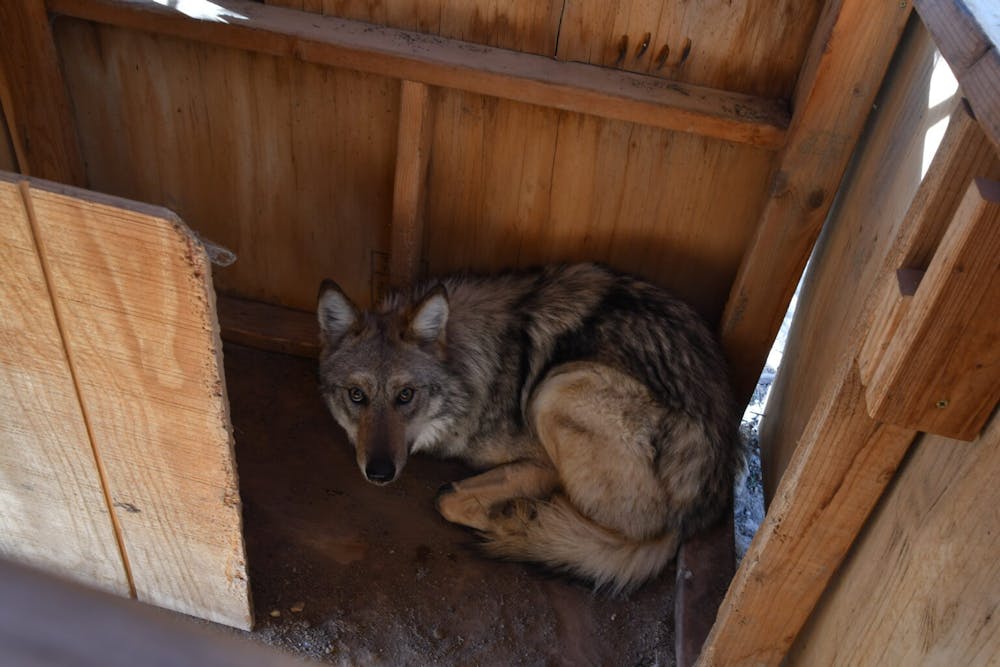This story was originally published by Source New Mexico
Two identical proposals to pay New Mexico ranchers for damages from incidents involving Mexican gray wolves cleared their first committee hurdles.
Senate Bill 26 and House Bill 164 share identical language and bipartisan support between each chamber.
The bills seek a $9 million appropriation that would direct the New Mexico Department of Agriculture to form partnerships with livestock loss authorities in Catron, Sierra and Socorro counties that would give direct payments to ranchers who lose livestock due to Mexican gray wolves in the areas.
If approved, the money would go to the Board of Regents at New Mexico State University. It seeks an appropriation starting in 2025 through 2027.
The Senate version, sponsored by Sens. Crystal Diamond Brantley (R), Pat Woods (R) and Siah Correa Hemphill (D) was unanimously passed by the Senate Conservation Committee on Tuesday.
At the same time, the house bill sponsored by Reps. Gail Armstrong (R-Magdalena), Luis Terrazas (R-Santa Clara), Jennifer Jones (R-Deming) and Tara Jaramillo (D-Socorro) passed the House Agriculture, Acequias and Water Resources Committee.
Mexican gray wolves, such as Asha, are named specifically in both bills as the breed that lawmakers and ranchers are concerned about.
Correa Hemphill said that having a state-sponsored solution will help ranchers get money they need for predator losses.
She said there are ranchers she represents in Southern New Mexico who have requested support out of concerns about the increase in the wolf population as the state initiates more Mexican gray wolf recovery programs.
Because of the perceived success of the Gray Wolf Recovery Program, Correa Hemphill argued that there will likely be an increase in livestock loss over the coming years and that ranchers need to be supported.
Right now, if a rancher believes a cow or calf has been killed by a Mexican gray wolf, they can report it to the County Livestock Loss Authority to request federal money to cover losses.
Get content from The Daily Lobo delivered to your inbox
However, representatives from the U.S. Department of Agriculture in the Senate committee hearing said federal laws compensating ranchers for confirmed wolf kills are becoming more stringent and difficult to prove.
“It would just be great to have two programs that people can reach out to so that they know that they’re going to be supported,” Correa Hemphill said.
If either bill were to pass, supporters say it would ensure compensation to ranchers despite the concerns with the federal program. However, the bill also states that federal funds must be used first, and any unused money that comes from appropriations would go back to the state.
Those who spoke in opposition of the Senate bill on Tuesday expressed critiques that the language in the proposal is too vague to ensure accountability.
Livestock loss and wolf presence payouts — where landowners can choose to allow wolves to roam on their property and receive money for the risk — have been discussed in existing county compensation programs utilizing federal money.
Wolf presence payouts are law in other states, such as California – a model that wildlife advocates and many ranchers support.
The New Mexico proposals are very clear that compensation can only be paid for confirmed wolf kills.
Bryan Bird with Defenders of Wildlife spoke out against the bill and even offered to help add language he deems necessary to specify accountability guidelines. Bird said the bill should not pass without “significant amendments” with safeguards to ensure integrity of any compensation program.
Chris Smith from WildEarth Guardians called the bill “bad” and voiced opposition in part because he does not see it supporting coexistence. He voiced concerns that inflating numbers of cattle claimed as collateral for compensation without thorough evidence procedures won’t do much to incentivize rancher responsibility.
Woods defended the bill and said these concerns are already addressed by the current program’s bylaws under the County Loss Authority.
Over on the house side, that version of the bill did receive similar criticism from one person.
Armstrong spoke in support of her bill with personal anecdotes on precautions she takes on her own ranch to ensure that she is protecting her livestock.
“I can shoot a coyote, but I cannot shoot a wolf,” Armstrong said.
She argued that it’s important to distinguish through cameras and other real-time devices which livestock were killed by wolves and which were killed by other predators.
The strategy to have both bills move at the same time during the legislative session is unclear. However, if one bill were to fail in one chamber, the other one could still move on. Only one of these bills can become law.
Accountability concerns
Smith argues that there is already more than enough federal money to cover losses after a wolf attack on livestock, and said the state should spend the $9 million request elsewhere.
He is also worried that the bill’s language over-emphasizes blaming wolves for predator attacks.
Many other predators like coyotes, bears and mountain lions kill livestock at more frequent rates, he said.
Correa Hemphill disagrees. “There’s always going to be some tension between the wolf population and livestock producers,” she said. “But this program really helps to lower the temperature and make coexistence more manageable and more equitable.”
Smith says ranchers face water shortages and extreme heat caused by climate change far more often than issues with wolves.
“Ranchers in Southern New Mexico are dealing with a lot of things, wolves being the least of them,” he said.
Dr. Emma B. Mincks is a freelance reporter for Source New Mexico.
Source New Mexico is part of States Newsroom, a network of news bureaus supported by grants and a coalition of donors as a 501c(3) public charity. Source New Mexico maintains editorial independence. Contact Editor Shaun Griswold for questions: info@sourcenm.com. Follow Source New Mexico on Facebook and Twitter.






